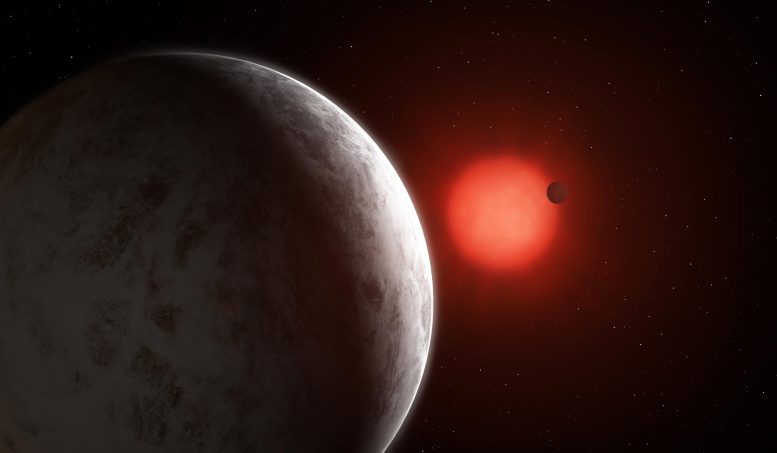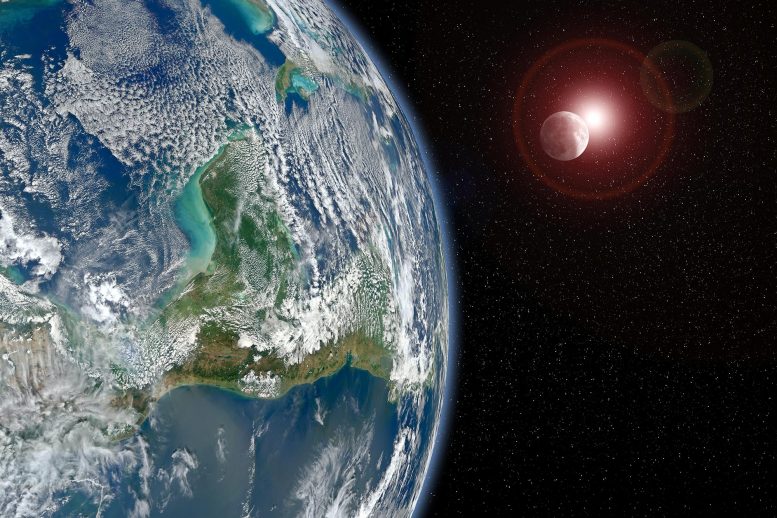I believe this star was previously considered as a candidate for earth-like exoplanets, but this research confirms that there are two earth-like planets,
International “RedDots” Team Has Detected a System of Super-Earth Planets Orbiting Nearby Red Dwarf Star
International “RedDots” Team Has Detected a System of Super-Earth Planets Orbiting Nearby Red Dwarf Star
TOPICS:AstronomyAstrophysicsExoplanetPopularUniversity Of New South Wales
By UNIVERSITY OF NEW SOUTH WALES JUNE 29, 2020

Artist’s impression of the multiplanetary system of newly discovered super-Earths orbiting nearby red dwarf Gliese 887. Credit: Mark Garlick
An international team of researchers has found multiple planet systems orbiting red dwarf star Gliese 887.
The international “RedDots” team – joined by Australian astronomers at UNSW Sydney, Macquarie University and University of Southern Queensland for this work – has detected a system of super-Earth planets orbiting the brightest red dwarf star in the sky, Gliese 887. The results were published in the journal Science on June 25, 2020.
Super-Earths are planets more massive than the Earth, but substantially less massive than our local ice giants, Uranus and Neptune. The newly discovered super-Earths could be rocky worlds, and lie close to the “habitable zone” of this red dwarf star – i.e. the zone where water could exist in liquid form on a planetary surface.
“The exciting thing about these planets are that they orbit a star so close to the Sun, and so very bright,” said UNSW-based planet hunter Prof Chris Tinney, who is a co-author on the paper. “We now know of thousands planets of Super-Earth-mass, or smaller. But most of those planets orbit distant and faint stars. Planets orbiting nearby stars are key for searches with future telescopes for both exoplanetary atmospheres, and eventually evidence for life.”
The team of astronomers monitored the red dwarf, using the HARPS spectrograph at the European Southern Observatory in Chile, and then combined that data with data from the Anglo-Australian Planet Search (using the 3.9m Anglo-Australian Telescope near Coonabarabran), the Planet finder Spectrograph (on Cerro Las Campanas in Chile) and the HIRES instrument on the Keck telescopes on Maunakea, Hawaii.
Using a technique known as “Doppler wobble,” they measured the tiny back and forth motion of Gliese 887 due to the gravitational pull of its planets. The regular signals correspond to orbital periods of 9.3 and 21.8 days, which indicates the presence of two super-Earths – known as Gliese 887b and Gliese 887c. The team estimates the surface temperature of the outer planet (Gliese 887c) to be around 70oC.
Gliese 887 is around 11 light years away, making it one of the closest stars to the Sun. It is much dimmer than, and about half the size of, our Sun. This means its habitable zone is closer to Gliese 887, than Sun’s habitable zone (in which the Earth orbits).
Dr. Sandra Jeffers, from the University of Göttingen and lead author of the study, said: “These planets will provide the best possibilities for more detailed studies, including the search for life outside our Solar System.”
Read Super-Earths Discovered Orbiting Nearby Red Dwarf Gliese 887 for more on this discovery.
Reference: “A multiple planet system of super-Earths orbiting the brightest red dwarf star GJ887” by S. V. Jeffers, S. Dreizler, J. R. Barnes, C. A. Haswell, R. P. Nelson, E. Rodríguez, M. J. López-Gonz’lez, N. Morales, R. Luque, M. Zechmeister, S. S. Vogt, J. S. Jenkins, E. Palle, Z. M. Berdi ñas, G. A. L. Coleman, M. R. Díaz, I. Ribas, H. R. A. Jones, R. P. Butler, C. G. Tinney, J. Bailey, B. D. Carter, S. O’Toole, R. A. Wittenmyer, J. D. Crane, F. Feng, S. A. Shectman, J. Teske, A. Reiners, P. J. Amado and G. Anglada-Escudé, 25 June 2020, Science.
DOI: 10.1126/science.aaz0795
International “RedDots” Team Has Detected a System of Super-Earth Planets Orbiting Nearby Red Dwarf Star
International “RedDots” Team Has Detected a System of Super-Earth Planets Orbiting Nearby Red Dwarf Star
TOPICS:AstronomyAstrophysicsExoplanetPopularUniversity Of New South Wales
By UNIVERSITY OF NEW SOUTH WALES JUNE 29, 2020

Artist’s impression of the multiplanetary system of newly discovered super-Earths orbiting nearby red dwarf Gliese 887. Credit: Mark Garlick
An international team of researchers has found multiple planet systems orbiting red dwarf star Gliese 887.
The international “RedDots” team – joined by Australian astronomers at UNSW Sydney, Macquarie University and University of Southern Queensland for this work – has detected a system of super-Earth planets orbiting the brightest red dwarf star in the sky, Gliese 887. The results were published in the journal Science on June 25, 2020.
Super-Earths are planets more massive than the Earth, but substantially less massive than our local ice giants, Uranus and Neptune. The newly discovered super-Earths could be rocky worlds, and lie close to the “habitable zone” of this red dwarf star – i.e. the zone where water could exist in liquid form on a planetary surface.
“The exciting thing about these planets are that they orbit a star so close to the Sun, and so very bright,” said UNSW-based planet hunter Prof Chris Tinney, who is a co-author on the paper. “We now know of thousands planets of Super-Earth-mass, or smaller. But most of those planets orbit distant and faint stars. Planets orbiting nearby stars are key for searches with future telescopes for both exoplanetary atmospheres, and eventually evidence for life.”
The team of astronomers monitored the red dwarf, using the HARPS spectrograph at the European Southern Observatory in Chile, and then combined that data with data from the Anglo-Australian Planet Search (using the 3.9m Anglo-Australian Telescope near Coonabarabran), the Planet finder Spectrograph (on Cerro Las Campanas in Chile) and the HIRES instrument on the Keck telescopes on Maunakea, Hawaii.
Using a technique known as “Doppler wobble,” they measured the tiny back and forth motion of Gliese 887 due to the gravitational pull of its planets. The regular signals correspond to orbital periods of 9.3 and 21.8 days, which indicates the presence of two super-Earths – known as Gliese 887b and Gliese 887c. The team estimates the surface temperature of the outer planet (Gliese 887c) to be around 70oC.
Gliese 887 is around 11 light years away, making it one of the closest stars to the Sun. It is much dimmer than, and about half the size of, our Sun. This means its habitable zone is closer to Gliese 887, than Sun’s habitable zone (in which the Earth orbits).
Dr. Sandra Jeffers, from the University of Göttingen and lead author of the study, said: “These planets will provide the best possibilities for more detailed studies, including the search for life outside our Solar System.”
Read Super-Earths Discovered Orbiting Nearby Red Dwarf Gliese 887 for more on this discovery.
Reference: “A multiple planet system of super-Earths orbiting the brightest red dwarf star GJ887” by S. V. Jeffers, S. Dreizler, J. R. Barnes, C. A. Haswell, R. P. Nelson, E. Rodríguez, M. J. López-Gonz’lez, N. Morales, R. Luque, M. Zechmeister, S. S. Vogt, J. S. Jenkins, E. Palle, Z. M. Berdi ñas, G. A. L. Coleman, M. R. Díaz, I. Ribas, H. R. A. Jones, R. P. Butler, C. G. Tinney, J. Bailey, B. D. Carter, S. O’Toole, R. A. Wittenmyer, J. D. Crane, F. Feng, S. A. Shectman, J. Teske, A. Reiners, P. J. Amado and G. Anglada-Escudé, 25 June 2020, Science.
DOI: 10.1126/science.aaz0795

